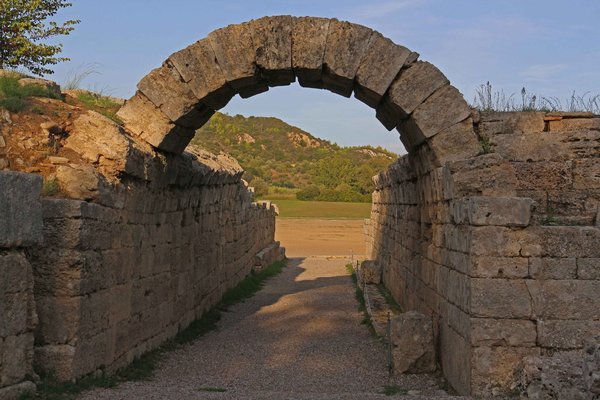Greece
Olympia
The Archaeological Site of Olympia holds several masterpieces from the Ancient Greek world and was the site of the original Olympic Games.
Already in the 10th century BCE, Olympia became a center of worship of Zeus. It flourished until 426 CE and was adorned with many great pieces of art (mostly sculptures such as the giant Olympia Zeus) and architecture. Olympia now is mainly remembered for the games that were held here every 4 years, which got their Pan-Hellenic character in 776 BCE. A stadium, hippodrome and associated training structures remain.
Community Perspective: The stadium and the museum are the parts not to be missed.
Site Info
Official Information
- Full Name
- Archaeological Site of Olympia (ID: 517)
- Country
- Greece
- Status
-
Inscribed 1989
Site history
History of Olympia
- 1989: Inscribed
- Inscribed
- Type
- Cultural
- Criteria
- i
- ii
- iii
- iv
- vi
Links
- UNESCO
- whc.unesco.org
- Official
-
- odysseus.culture.gr — Hellenic Ministry of Culture and Tourism
All Links
UNESCO.org
- whc.unesco.org — whc.unesco.org/
Official Website
- odysseus.culture.gr — Hellenic Ministry of Culture and Tourism
News Article
- Aug. 7, 2021 euronews.com — Site of first ancient Olympics at risk as fires rage in Greece
- Feb. 17, 2012 bbc.co.uk — Robbery at Ancient Olympia museum
- July 18, 2011 uni-mainz.de — Olympia hypothesis: Tsunamis buried the cult site on the Peloponnese
Community Information
- Community Category
- Archaeological site: Ancient Greece
Travel Information
Peloponnese hotspot
Recent Connections
-
Perfect Inscriptions
1989 -
Bronze Age
Crit iii: "Settlements and necropolises… -
Neolithic age
The Pan-Hellenic sanctuary has been est…
Connections of Olympia
- Individual People
-
-
Emperor Nero
"Nero was convinced to participate in the Olympic Games of 67 in order to improve relations with Greece and display Roman dominance. As a competitor, Nero raced a ten-horse chariot and nearly died after being thrown from it He also performed as an actor and a singer. Though Nero faltered in his racing (in one case, dropping out entirely before the end) and acting competitions, he won these crowns nevertheless and paraded them when he returned to Rome. The victories are attributed to Nero bribing the judges and his status as emperor" -
Pausanias
Pausanias is most at home in describing the religious art and architecture of Olympia and of Delphi. (wiki)See www.theoi.com
-
- Trivia
-
-
Olympic Venues
venue for shot put events in Athens 2004 -
Modern Board Games
7 Wonders (2010) and expansions -
In Video Games
Assassin's Creed Odyssey - Temple of Zeus, Temple of Hera; Age of Mythology (Greeks - Zeus: his own statue in Olympia (no more existing))
-
- History
-
-
Neolithic age
The Pan-Hellenic sanctuary has been established in the history of culture, as the most important religious, political and sports centre, with a history that dates back to the end of the Neolithic times (4th millennium BC) (OUV) -
Classical Greece
: the temple of Zeus, built in 470-457 BC, is a model of the great Doric temples constructed in the Peloponnese, as well as in southern Italy and in Sicily during the 5th century BC; the Nike by Paionios, sculptured circa 420 BC, so lastingly influenced iconographic allegories of victory that neoclassic art of the 19th century is still much indebted to it (OUV) -
Historical Events
"celebration of the Olympic Games from 776 BC to 393 AD" -
Bronze Age
Crit iii: "Settlements and necropolises from the Bronze Age have been unearthed along the banks of the Alpheios river." (OUV)
-
- Architecture
-
-
Sites from antiquity with identified architects
Porch of AgnaptusSee en.wikipedia.org
-
Restored by anastylosis
Philippeion -
Temenos
The temenos of Zeus (wiki)
-
- World Heritage Process
-
-
Perfect Inscriptions
1989
-
- Religion and Belief
-
-
Goddesses
Heraion for Hera is the place where the torch of Olympic flame is lit -
Cult of Cybele
The Metroon, dedicated to the Mother of the Gods, sometimes called Cybele. (see link)
-
- Human Activity
-
-
Historical Graffiti
At the tunnel walls before entering the track, made by athletesSee books.google.nl
-
Locations for playing sport
Various arenas (athletics, wrestling etc)
-
- Constructions
-
-
Bouleuterion
"The bouleuterion, or Council House, one of the most ancient and important buildings of the sanctuary of Olympia, was the seat both of the Elean Senate, whose members were responsible for the organisation of the games, and possibly of the hellanodikai, or umpires. This is where the athletes registered and drew lots, and where their names and the program of events were announced. It was also where any offences and pleas were tried, and where penalties were decided." See
-
- WHS on Other Lists
-
-
Seven Wonders of the World
Statue of Zeus at Olympia: only a single column of the temple that surrounded it is left standing. Criterion I : The sanctuary of the Altis contained one of the highest concentrations of masterpieces of the ancient Mediterranean world. Many have been lost, such as the Olympia Zeus, a gold-and-ivory cult statue which was probably destroyed by Pheidias between 438 and 430 BC and one of the seven wonders of the ancient world.” (OUV)
-
- Timeline
-
-
Built in the 8th century BC
"The Olympic Games were celebrated regularly beginning in 776 B.C." - remaining monuments are a little later (f.e. Temple of Zeus (470-457))
-
- WHS Hotspots
-
-
Peloponnese hotspot
170km
-
- Literature & Film
-
-
Asterix
Astérix aux Jeux olympiques / Asterix at the Olympic GamesSee en.wikipedia.org
-
News
- euronews.com 08/07/2021
- Site of first ancient Olympics at …
- bbc.co.uk 02/17/2012
- Robbery at Ancient Olympia museum
- uni-mainz.de 07/18/2011
- Olympia hypothesis: Tsunamis burie…
Recent Visitors
Visitors of Olympia
- 4lex
- Afshin Iranpour
- Alexander Barabanov
- Alexander Lehmann
- AlexSchedel
- ALS
- A. Mehmet Haksever
- Ammon Watkins
- Ana
- AndreaTLV
- Angela Vandyck
- Anna Wludarska
- Argo
- Artur Anuszewski
- Ask Gudmundsen
- Aspasia
- Astraftis
- Atila Ege
- AYB
- bergecn
- Bill Maurmann
- Bin
- Bropyk
- Caspar
- CeeMon
- Cezar Grozavu
- Chantal den Haan
- chapnis
- Chinmaya
- ChrisN
- Christer Sundberg
- christof
- Christoph
- Christravelblog
- ClaraHH
- Cluckily
- Clyde
- Col
- Corinne Vail
- Cristina Erba
- Csaba Nováczky
- ctravel
- Cyberczar
- dana144
- Daniela Hohmann
- Daniel Gabi
- David Aaronson
- David Berlanda
- debatecoach
- Deffra
- del
- Dimitar Krastev
- Dimitrios Polychronopoulos
- Dirk-pieter
- Don Irwin
- DutchHorn
- Echwel
- Eirini
- Elaine McArdle
- Elia Vettorato
- eljx1988
- Ellen Nielsen
- Els Slots
- Ertai
- Eva Kisgyorgy
- Evgenii
- Fan Yibo
- Farinelli
- Fede1203
- Feldhase
- Felicité
- Femke Roos
- Fernweh
- FK
- Frederik Dawson
- Geo.Mav
- George Gdanski
- GeorgeIng61
- GerhardM
- Gernot
- Giannis75
- Grzegorz Andruszkiewicz
- Hadrianus
- Harald T.
- Harry Mitsidis
- H Beswick
- henrik_hannfors
- henryjiao18
- Hubert
- Hunstow
- Iain Jackson
- Ivan
- Ivan Rucek
- Jacob Choi
- janem
- Jarek Pokrzywnicki
- Jay T
- Jeanne OGrady
- Jens
- Jesse S 2010
- Jezza
- Joel on the Road
- Jonas Kremer
- Jonas Martinsson
- jonathanfr
- Jonoprout
- Joyce van Soest
- JR's HERITAGE SITES
- Just_hatched
- Justin
- k2flake
- KarenBMoore
- KateY
- Kbecq
- Kelly Rogers
- Klaus Freisinger
- KngAlaric
- Knut
- Krijn
- Krzysztof B
- Kurt Lauer
- La Concy
- Lara Adler
- Laurine
- LaVale
- Lisu Marian
- Lithobates
- Loic Pedras
- Luboang
- Lucio
- Ludvan
- Luis Filipe Gaspar
- Maciej Gil
- Mahuhe
- Malgorzata Kopczynska
- marc Rouserez
- Mardigny
- Marlies van Wolfswinkel
- Martina Rúčková
- Marty
- maryhattie
- Mateusz
- Matthewsharris
- Max
- MaxHeAnouBen
- MaYumin
- MichaelH
- michaelsballard
- Michael Turtle
- Mihai Dascalu
- Mikko
- Mikko Syrjä
- Milan Jirasek
- MMM
- Monica Tasciotti
- MoPython
- Mozzer76
- Mstrebl1990
- nan
- Nasebaer
- NH1984
- Nicolas
- Nihal Ege
- opperpco3
- PabloNorte
- Patrik
- Paul Schofield
- PeterH
- Petteri
- Philipp Leu
- Philipp Peterer
- phillipmeng
- Pieter Dijkshoorn
- Pink Bunny
- Piotr Wasil
- Pradip Tripathy
- Priyaranjan Mohapatra
- Rafał Kałczuga
- Ralf Regele
- Randi Thomsen
- Reiseblog
- Reza
- Riccardo Quaranta
- Rick Ohm
- Roger Ourset
- Roman Bruehwiler
- Roman Raab
- Rubbie
- Rudegirl
- Samato
- Sclowitz
- Shandos Cleaver
- SirLoydd
- Slavi
- Solivagant
- Stanislaw Warwas
- Sutul
- Svein Elias
- Szabolcs Mosonyi
- Szucs Tamas
- Taotao Chen
- Tarquinio_Superbo
- Tatiana Nikulnikova
- TheTravelingRanger
- Thomas Buechler
- Thomas Harold Watson
- Thomas van der Walt
- Tim Allen
- tony0001
- triath
- Tsunami
- Twobaconsandaboston
- usagi1974
- Vanessa Buechler
- Vernon Prieto
- Viaje al Patrimonio
- Waxwing
- Westwards
- WILLIAM RICH
- Wimmy
- Yevhen Ivanovych
- Yongcheng Liu
- Zoë Sheng
Community Reviews
Show full reviews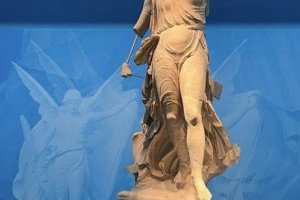
I visited Ancient Olympia on the very day of the opening ceremony of the Paris Olympic Games 2024, hoping to catch some special activities or celebrations connecting the ancient birthplace of the Olympics with the modern global event. To my surprise, the site was peaceful and quiet, with no visible link or festivities marking the occasion. Despite the significance of the date, there was nothing at all to highlight the connection between the ancient games and today’s Olympics. Nevertheless, the visit was far from disappointing. Walking among the ruins of the ancient stadium, temples, and training grounds offered a humbling glimpse into the origins of this world-renowned sporting tradition.
One of the most impressive sights was the Temple of Zeus, once home to the massive statue of Zeus, which was considered one of the Seven Wonders of the Ancient World. Although now largely in ruins, the remaining columns and foundation still convey a powerful sense of grandeur and magnificence. Standing there, it’s easy to imagine the scale and awe that this temple inspired in visitors thousands of years ago. Nearby stands the Temple of Hera, one of the oldest temples at Olympia and an important part of the site's legacy. It’s here that the modern Olympic flame is lit before every Olympic Games, during a solemn and theatrical ceremony using a parabolic mirror to harness the sun’s rays, a symbolic gesture linking ancient ritual to modern global unity. Approaching the Ancient Stadium, it was tempting to …
Keep reading 0 comments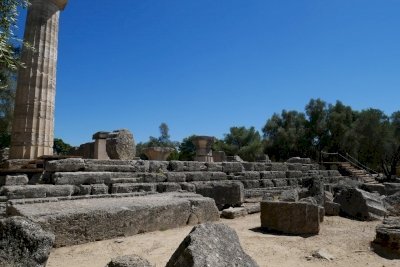
Spanning a 1.000 years the most famous pan hellenistic games were held at Olympia starting around 700 BCE and ending in 393 CE. Considering that Greece became part of the Roman Empire around 150 BCE, the games were not just a Greek tradition, but also a Roman one. The Roman Emperor Nero participated himself and you can find the ruins of his house at the site. It was also a Roman Emperor who ended the tradition, Theodosius I, the last Emperor of both the Western and Eastern Roman Empire and of Theodosian Wall fame. The end came due to the ascendance of Christianity and the banning of pagan traditions.
What you find nowadays is a large archeological site with a focus on sports. There is the stadium and entering it via the gate has a special feel to it. There are plenty of houses for the athletes. But to me the true highlight is not sports related, it's the ruins of the Zeus Temple of Olympia. The Zeus statue that is housed was one of the Seven Wonders of the World. Supposedly, it was lost in Constantinople in a fire in 475 CE. The workshop of the famous sculptor Phidias who created the Zeus status is nearby.
Similar games were held in other Greek cities, most notably Delphi. Interestingly, Olympia also had an oracle, so there is an overlap between these two sites. Still, both sites feel different and are great additions to the list.
Last but …
Keep reading 0 comments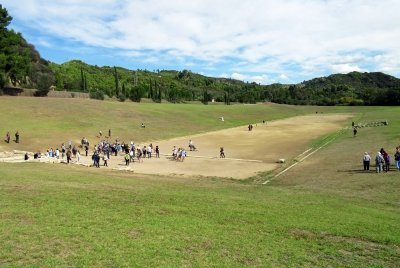
I find it fitting to write about Olympia in the days following the extinguishing of the Olympic flame for the 2018 Winter Games since I visited Olympia the day after the flame was lit last October. Sadly, there was no trace left of the ceremony, in which Greek women representing Vestal Virgins light the torch at the ruins of Olympia's Temple of Hera; by the time I arrived, the crowds had left and the Olympic torch was already en route to Athens, from where it would be flown to South Korea. As other reviewers have noted, the archaeological site of Olympia is vast and replete with ruins of temples, a gymnasium, lodging, and baths, as well as an excellent museum. Most impressive is the Olympic stadium, where the ancient world's fastest men would compete for fame and glory. Perhaps the most well-known feature of the ancient games was the Olympic truce, which allowed athletes and spectators to travel to and from the games in safety. I'm a bit of a modern Olympics junkie, so I appreciated the opportunity to visit the original site of the games in advance of the 2018 Winter Olympics, in which the Olympic truce took on even greater meaning.
Logistics: Olympia is a bit remote on the Pelopennese, but can be reached by private transportation or via trains and buses. Cruise ships offering tours of Olympia will dock at the port of Katakolo.
Keep reading 0 comments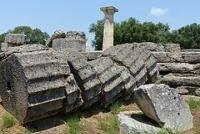
I visited this WHS in June 2014. It's quite far from any other town or village, so this together with the fact that it was 39 degrees when I visited, must have kept the crowds at bay. From all the classical WHS I visited in Greece, this seemed to be the most vast and clearly distinguishable group of ruins. That said, what is left ruins but I found something interesting and different in almost every structure. The archaeological museum houses several ornaments, stone statues and bronze statues (most important is the winged Nike of Paionios) and it complements the archaeological site quite well. The main areas worth mentioning are the following: the Leonidaion and the Palestra (several lined doric columns in very good condition), massive ruins of the Temple of Hera and the Temple of Zeus with several inscriptions still visible, the workshop and thermal baths where there are excellent mosaic floors visible and marble carvings, and finally the impressive Ancient Olympic Stadium with an intact arched entrance and start and finish lines visible. I must say this is one of my favourite WHS in Greece.
Keep reading 0 comments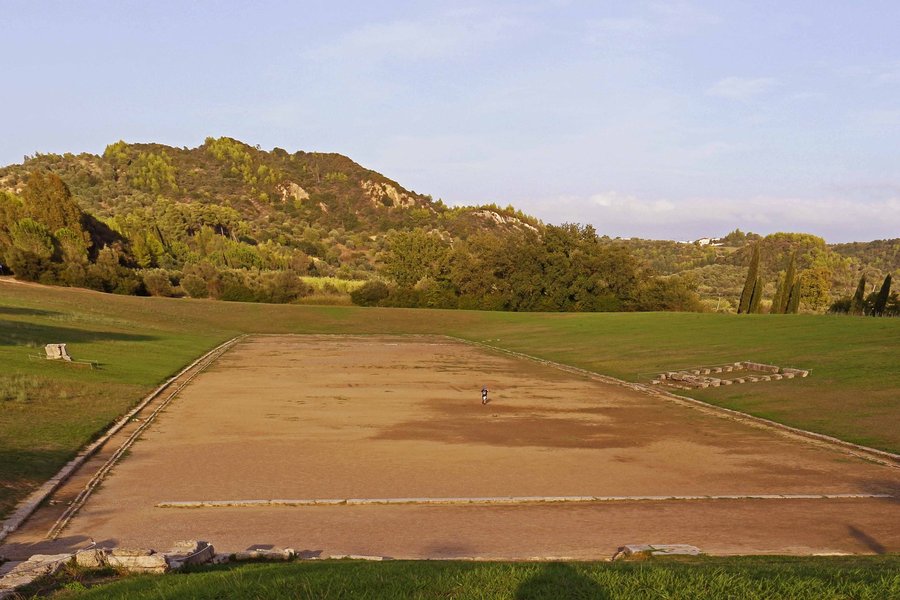
We arrived by boat in Katalokon and since we missed a bus we rented a car at the port and drove quite easily to Olympia in about half an hour. Arriving there around one thirty we were amazed to learn that the museum closed at 3pm and the archaeologic site at 4! This left us very little, too little time in the museum. It displays first class art works, among them the famous Hermes statue by Praxiteles and impressive groups of statues that one crowned the tympanon of the temple of Zeus. But I was most taken by the incredibly refined metal works, among them many Griffins. The museum has also many good notes about the history of the place and in three languages! This is something I have missed in many WCTs! All in all it would be worth to spend a couple of hours in the museum.
The archaeologic site was also surprisingly impressive: Despite the fact that there are only ruins, the vastness of the place and its architectonical arrangement can be felt very excellently as you walk through it. Very touching to see the base of the great temple of Zeus which was home to the statue of Phidias, one of the seven wonders! Very nice also the pavilion-like Phillipeum, das Alexander the Great built for his father. This is probably the incarnation of the romanticism for ruins in the 19th century. During our visit the abundance of blossoming trees (some of them historically clearly incorrect …
Keep reading 0 comments
There is probably no ancient archaeological site anywhere in the world that has more relevance on today's world than Olympia. The history of the Olympic Games reaches back to the 8th century BC and continues today (OK, not without interruption...), so to visit Olympia should be interesting to everybody. Granted, at first the sight of ancient Olympia is a bit of a letdown, because there is really not a single structure still standing, mostly due to a number of earthquakes that covered the site under metres of mud. But then, seeing places like the site where the Olympic flame is lit every two years for the Games, and especially the original stadium (and being able to actually run there), is really quite amazing. You need a little imagination, but it's pretty easy to feel like an athlete of ancient times vying for an olive wreath there...
Definitely a must-see for anybody even slightly interested in Antiquity.
Keep reading 0 comments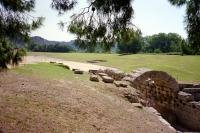
Continuing my Greek journey from Athens and Delphi, I hopped on the narrow-gauge train in Corinth reaching the end station of Olympia a couple of hours later. Finding my way between the few spots of shadow, hiding from an almost torturing sun, shining over the modern village of Olympia I soon found my way to my hotel. I must say that I quickly got to like this little village that was now resting in the afternoon heat. Good food and a relaxing atmosphere is paired with unfortunately too many souvenir shops catering to the busy day-visitors from Athens that comes at lunch and leaves a couple of hours later. But Olympia definitely deserves a better destiny. Why not stay here for a night and enjoy. Then you will also get another upside - to visit the ancient Olympia in the early morning when the tourists have not yet arrived. Wondering around the overthrown columns all alone, pass the bath houses and the wrestling schools through to the stadium quickly takes you to another world. And don't forget the excellent museum, conveniently located nearby, provides you with an insight in the life of sports during the 700 years Olympia functioned as an annual meeting point.
Keep reading 0 comments
The ruins of Olympia contain their fair share of Temples etc but THE place to go to is the Stadium where the ancient Games were held (photo). There you can still see the start and finish lines, 1 “Stadion” apart” – the latter is closest in the photo. On the right, half way down, was the judges’ enclosure. The location at each end, of the “cippi”, columns for running round in multi-“lap” races, can also be seen. Another point of interest, just before what was a covered passage leading into the stadium (entrance at bottom left of photo), are the pedestals where the statues of Zeus, paid for by the fines of those caught cheating, were placed! The Games were still held through to the Roman era (In fact, they continued into Byzantine times until 394CE) and Nero, an avid charioteer, went to Olympia to take part in the 211th Olympiad in 67CE. He was, perhaps wisely, allowed to win despite falling off! The race course, originally to the right of the Stadium, was destroyed in floods from the nearby river Alpheios and there is nothing to see (To see a reasonably complete Hippodrome go to Tyre instead – see my review).
Keep reading 0 comments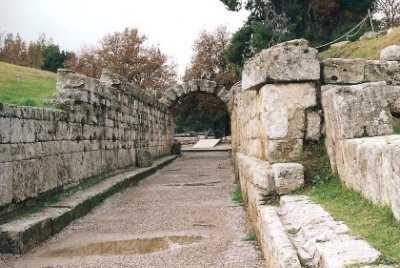
This archeological site is still quite intact. Well, the outlines at least are (not the buildings). At the center is the Zeus temple. Around it is the residence of priests, the training rooms facilities for the athletes, the guesthouses.
Via a passageway, called the Crypt, you reach the stadium. The place where the athletic games were held measured 212 x 28 meters. There were no seats, but the embankment could hold 45.000 spectators.
In the nearby museum, you can see a model of how Olympia looked like at its heydays. An amazing, bustling site it must have been: think of the athletes practicing, but also the numerous spectators and officials that were around. Not unlike an Olympic Village nowadays, but on such small grounds.
Keep reading 0 comments
